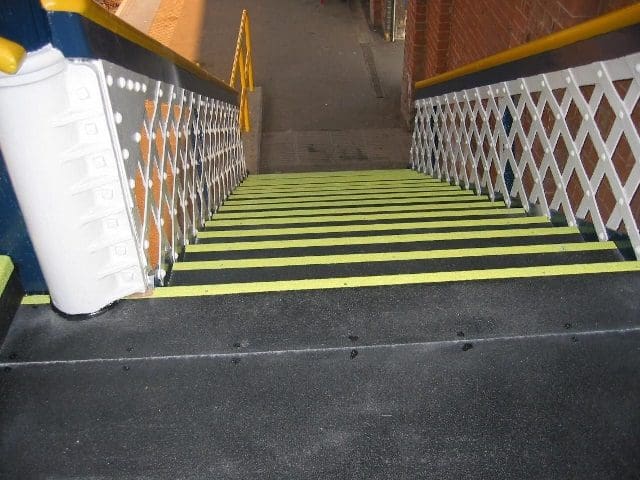
Train stations cause over 200 severe slips, trips and falls that lead to injuries to members of the public annually.
It’s a major problem that will only increase as people return to rail travel and train stations get busier once again.
As we head through summer, and into warmer weather, train station managers are provided with the perfect opportunity to upgrade safety solutions as footfall lowers during the school holidays and while there is less chance of wet weather affecting the essential works.
Barry Eagle, founder and CEO at GripClad, a supplier of anti-slip solutions to a variety of industries, including railways, leans on his 20 years’ experience of making train stations safer to provide insight to those working in the rail industry.
What makes stations unsafe?
Train stations, all of which have been constructed over the past 200 years or so, have seen millions of passengers in the years gone by. These often beautifully built brick buildings are, however, not necessarily the safest buildings in the world. Traditional building materials such as concrete, stone and wood, aren’t always designed for true anti-slip performance.
Take metal steps, or those inlaid with natural stone, for example. Whilst they may look beautiful, on a day-to-day basis, these are trip hazards! Similarly, in wet weather, train station platforms or entrances can be incredibly slippery, and in ice, grit always needs placing down to prevent accidents.
How can stations be made safer?
Improve stair safety
Stairs are common places for people to stumble, and when there’s been wet weather or a lot of mud trapsed through, it only gets worse. As well as keeping stairways clean and clear, using stair treads or stair nosings can help to reduce the risk of slips.
Made with GRP (Glass Reinforced Plastic or Fibreglass Reinforced Plastic), these are lightweight, retrofit solutions on stairs and walkways that protect the original construction but provide an anti-slip solution to visitors.
As well as increasing the safety of the steps, you can also use anti-slip tape on the handrails, or anti-slip handrails. For those who are older, or with limited mobility, handrails are key to enable them to use stairs, but metal handrails in particular can be slippery. A non-abrasive anti-slip tape is suitable for our hands, and doesn’t cause any discomfort, while ensuring the safety of users. Similarly, a GRP handrail is lightweight to install, and unlike its steel counterparts, won’t rust in wet weather and isn’t cold like steel is in winter.
Install anti-slip sheets at entrances
Train station entrances are often made to be easily cleaned, but this also means they’re easy to slip on. GRP anti-slip sheets and stair tread covers can be easily affixed to the floor are a simple solution that enables users to feel secure in their footing the moment they walk into a train station and also provides you, as a rail professional, the knowledge that you have provided visitors with anti-slip solutions that will only benefit them.
Add anti-slip tactile paving
Tactile paving can be dangerous if installed wrong, or with a slippery material. By using an anti-slip material, you can prevent any danger, and also have a more durable tactile paving system.
As tactile paving is used on the edge of train station platforms, near stairs and throughout key points at train stations, it’s important that any tactile paving installed doesn’t cause any slip accidents. This is why using an anti-slip tactile paving solution is always a good idea.


